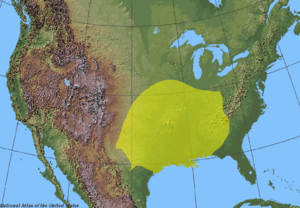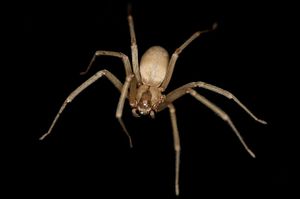We need you! Join our contributor community and become a WikEM editor through our open and transparent promotion process.
Brown recluse spider bite
From WikEM
Contents
Background
- Brown violin shape on cephalothorax (fiddleback)
- In Southern midwestern US
- Loxosceles family
Mechanism
- Venom contains variety of cytotoxic enzymes, principally Hyaluronidase and Sphingomyelinase-D, which cause a necrotic wound
- Hyaluronidase: facilitates the penetration of the venom into tissue but does not induce lesion development
- Sphingomyelinase-D: causes necrosis and lesion formation by initiating the release of pro-inflammatory mediators (thromboxanes, leukotrienes, prostaglandins, and neutrophils)
Clinical Features
- Bite is initially painless
- Mild reaction (most common)
- Mild erythematous lesion that later becomes firm and heals without scar
- Severe reaction
- Begins with mild-severe pain several hrs after bite accompanied by erythema and swelling
- Hemorrhagic blister then forms surrounded by vasoconstriction-induced blanched skin
- By day 3 or 4 hemorrhagic area may become ecchymotic
- Leads to "red, white, and blue" sign (erythema, blanching, ecchymosis)
- By end of first week ecchymotic area may become necrotic with eschar formation
- Systemic effects (rare)
- Occur predominantly in children 24-72hr after the bite
- Include nausea/vomiting, fever, arthralgias, DIC, rhabdo, renal failure
Differential Diagnosis
Envenomations, bites and stings
- Mammalian bites
- Closed fist infection (Fight bite)
- Hymenoptera stings (bees, wasps, ants)
- Spider bites
- Brown recluse
- Black widow
- Tarantula
- Scorpion envenomation
- Marine toxins and envenomations
- Snake bites
Evaluation
- Definitive diagnosis is achieved only when the biting spider is positively identified
- Labs
- May be remarkable for hemolysis, hemoglobinuria, and hematuria
- Coagulopathy may be present (elevated fibrin split products, decreased fibrinogen concentrations, and a positive D-dimer)
- Increased PT and PTT
Management
- Local wound care and tetanus prophylaxis
- Antibiotics are indicated only if signs of infection exist; secondary infections are uncommon
- Although some texts recommend Dapsone, it has been shown to be of limited benefit and is associated with hemolysis (in G6PD patients) and methemoglobinemia
Disposition
- Typically discharge home


